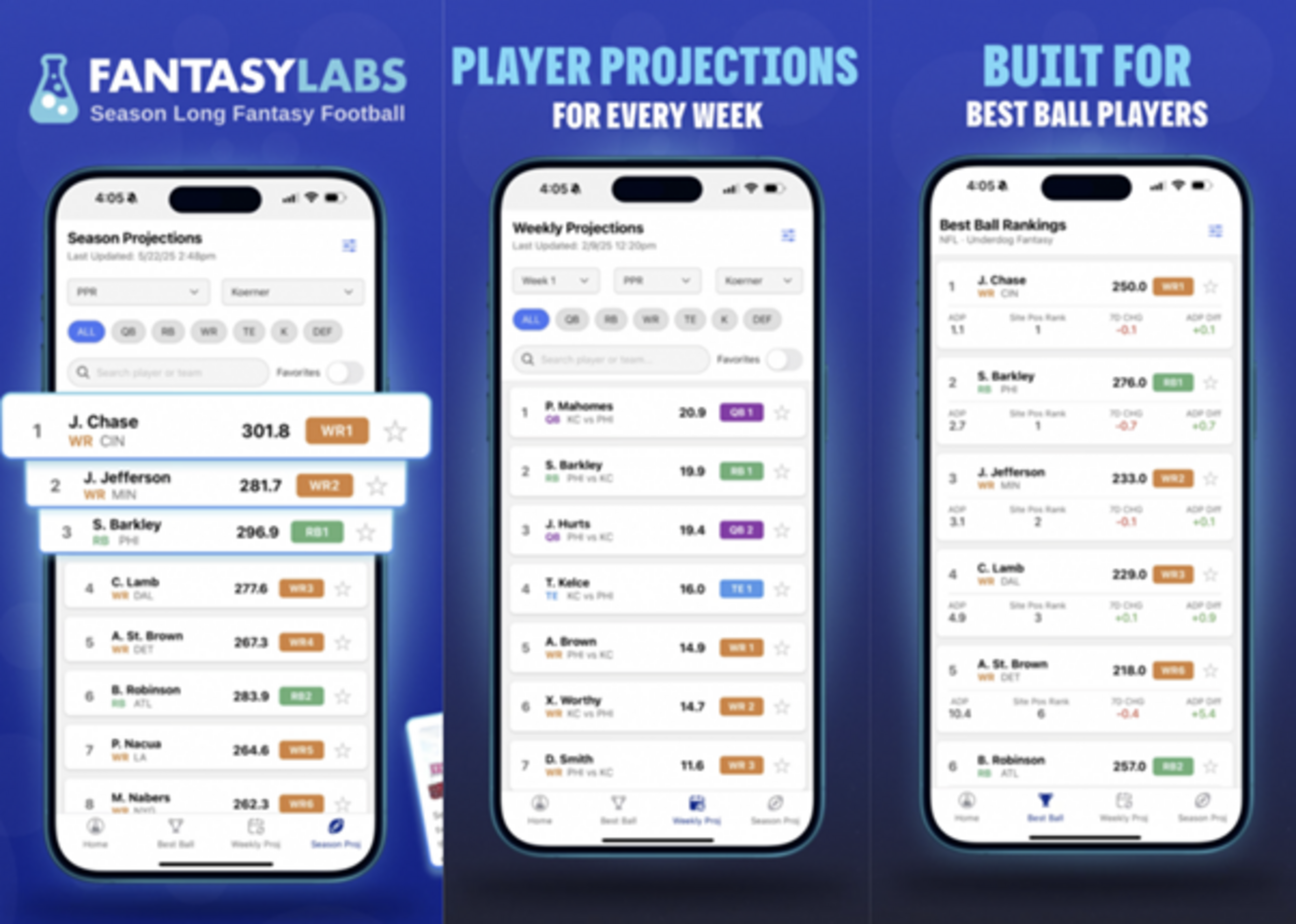
Yahoo Fantasy Football rankings and ADPs to target
Where you choose to host your fantasy football league is one of the most crucial decisions you’ll make. While all the unique features that different platforms offer—remember when live scoring was considered an upgrade?—are enjoyable, that’s not my main focus here. What truly matters are the default rankings used by each site.
You might show up to your draft armed with detailed tiers, rankings, and a thoughtful approach to targeting certain positions in specific rounds. But how many of your league mates come in that prepared? Probably just a few. Many may only have a game plan for the early rounds and then improvise as the draft goes on.
This is where default rankings play a significant role. Facing a tough choice at running back in Round 9? Many drafters will simply select the highest player left in the site’s rankings—especially if they haven’t done much prep.
Default rankings can differ a lot from one platform to another, especially in the middle and late rounds. For those who have prepared, this creates chances to snag undervalued players. If you participate in several leagues across different platforms, you can draft Player A at a discount wherever he’s lower in the rankings, skip Player B, and do the opposite in leagues where their default order flips.
First up in this series of articles, we'll take a look at players Yahoo is lower on than our season-long projections indicate they should be. We'll be using the consensus half PPR rankings unless otherwise noted.
And don't forget to sign up for your fantasy football league on Yahoo Sports!
Use promo code YARD20 for $20 off your FantasyLabs fantasy football subscription!

Quarterbacks
Quarterbacks are the most important position in real football, but they may be the least critical in fantasy football. That’s not because they fail to score points—in fact, their output is steady and predictable—but because the gap between the top quarterback and the 10th or 12th option (outside of non-standard scoring leagues) is far smaller than at other positions.
For this reason, you’ll find fewer quarterbacks highlighted here compared to other positions. I’ll also identify a few candidates to avoid on Yahoo, since they’re being selected earlier than their value warrants. In my experience, QBs tend to get drafted too early in redraft leagues, so targeting the 10th or 12th passer off the board is often the most effective approach.
Josh Allen: Yahoo Ranking 28 – Labs Ranking 24
I debated whether to include Allen, as his normal ADP of 20.4 actually classifies him as a fade based on our season-long projections. Still, if your league gives more weight to site rankings than ADP, Allen could offer value. Our forecasts place him as the top QB, outscoring Lamar Jackson by 14 total points—a modest but meaningful margin. With Jackson ranked ahead of Allen on Yahoo, Allen may be slightly undervalued there.
I’m not going out of my way to take Allen—or any quarterback, honestly—but if you have a late second- or early third-round selection and Jackson is gone, grabbing Allen early is justifiable.
Caleb Williams: Yahoo Ranking QB13 – Labs Ranking QB10
Even though Yahoo ranks Williams ahead of our Labs grade, his Yahoo ADP of 116 makes him appealing. With Williams slotted as QB13 on Yahoo—and considering most leagues have 10 or 12 teams—the run on quarterbacks slows after each team claims a starter.
If you don’t land Allen, the savvy move is to wait on quarterback. The gap between our QB10 (Williams) and the next few passers is minimal. We forecast a smaller difference between QBs 10 and 13 than between QBs 1 and 2, so by holding off until others have secured their first QB, you can strengthen other positions and still land someone comparable.
There are also plenty of reasons to expect a big leap from Williams. New head coach Ben Johnson—the former Lions offensive coordinator who made Detroit’s offense so productive—should be a huge asset. The Bears further supported Williams by drafting tight end Colston Loveland in the first round, nabbing wide receiver Luther Burden in the second, and using another second-round pick on an offensive tackle.
With returning receivers Rome Odunze and DJ Moore, Williams has a wealth of weapons. And given Chicago’s defensive concerns, he could find himself in plenty of high-volume passing situations. It wouldn’t be a shock if he finished as a top-five quarterback.
Dominate your Best Ball and season-long fantasy football leagues with FantasyLabs’ brand-new app that's available in the Apple App Store and on Android!

Running Backs
While running backs may be less critical in real-life football, they remain the cornerstone of fantasy leagues. Even in an era where passing dominates the NFL, running backs continue to set themselves apart as the main differentiators in fantasy football.
One way to illustrate this is by looking at Pro Football Reference’s “Value Based Drafting (VBD)” metric. VBD is similar to “Wins Above Replacement” (WAR) in baseball: it measures a player’s fantasy value by subtracting the production of the lowest-ranked starter—RB24 in most standard leagues, since teams typically must start two backs—from the total points of each running back. This gives a direct sense of how much value a back adds over a baseline, showing just how crucial the top backs remain.
Take last season as an example. Saquon Barkley was the top player in VBD, finishing 163 points ahead of the RB24 benchmark. The next two top VBD performers were also running backs, and in total, running backs filled six of the top 10 spots overall.
Here are a few running backs who are undervalued on Yahoo and could offer strong returns:
De’Von Achane: Yahoo Rank 16 – Labs Rank 11
Although our overall ranking of Achane isn’t drastically higher than Yahoo’s, we do have him three spots higher at the position (RB5 compared to Yahoo’s RB8)[4]. Achane stands out for his elite points-per-touch efficiency in his NFL career. The main questions involve his health and potential workload, but Miami moving on from Raheem Mostert means there’s less competition for touches. Achane’s breakaway speed brings elite upside, and even if he’s not a true workhorse, that kind of efficiency makes him a strong pick in the second round—possibly later, depending on your draft.
Kyren Williams: Yahoo Rank 25 – Labs Rank 17
On the other side, Williams was the definition of a workhorse last year for the Rams, ranking third among all backs in carries. Sean McVay favors leaning on a single back, and Williams’ RB12 placement on Yahoo is puzzling considering his projected volume—typically the biggest driver of fantasy success. The Rams should remain productive on offense, providing Williams with important touchdown upside. He’s usually available at the Round 2/3 turn on Yahoo, making him a savvy pick for managers with an early selection who open with a receiver.
James Cook: Yahoo Ranking 34 - Labs Ranking 25
The nine-slot gap between Cook and Williams in the rankings looks significant, but projections show there’s only a five-point difference between the two running backs. Williams is likely to see more touches, yet Cook’s opportunities may carry more value because he’s part of the explosive Bills offense, which finished second in points per game last year.
One drawback for Cook is that Josh Allen often steals goal-line work, scoring 12 rushing touchdowns in 2024. Still, Allen’s rushing attempts have steadily declined the past three seasons, and that trend should continue. As a result, Cook profiles as either a low-end RB1 or one of the top RB2s and makes for a strong pick in the middle of Round 3.
Kareem Hunt: Yahoo Ranking 231 – Labs Ranking 199
A favorite tactic for season-long leagues is targeting backup running backs who are just one injury away from a starting job. Unlike receivers—where lesser players rarely draw many targets—running backs will see opportunities simply because of the position's demands.
This approach gets even better if the backup is in a high-octane offense, raising the odds for touchdown chances. That’s the case with Hunt. Not only does he retain some PPR value on passing downs, but if Isaiah Pacheco were to miss time, Hunt would step into a major role.
Since Hunt’s average draft position is so late, he’ll often go undrafted in home leagues. Depending on bench space, he’s a worthwhile final-round stash in case he ends up getting starter touches at some point.
Use promo code YARD20 for $20 off your FantasyLabs fantasy football subscription!

Wide Receivers
It’s crucial to pay attention to your league’s scoring rules for wide receivers. High-volume possession guys such as Amon-Ra St. Brown become even more valuable in full-PPR formats, whereas in non-PPR leagues, someone like Brian Thomas gains ground—since he racked up more yards than ASB despite catching 38 fewer passes.
We’re using half-PPR rankings here, which try to balance those extremes, but make sure you reference the rankings appropriate for your league format if you’re playing under a different system.
Justin Jefferson: Yahoo Ranking 5 – Labs Ranking 2
This ranking difference mainly comes from Yahoo bumping up running backs in their default order compared to wide receivers. They slot three backs between consensus top picks Ja’Marr Chase and Jefferson, while our staff doesn’t have Jefferson ranked lower than No. 3.
This is another spot where knowing your league’s scoring system matters. In full PPR, Jefferson is a clear pick at second overall. If you’re drafting anywhere from the second to the fifth slot, he’s a nearly automatic pick. I would still take him at No. 2 in half-PPR, but in non-PPR, it makes more sense to put running backs above him.
Drafting strategy-wise, having an early pick lets you circle back for players like Kyren Williams or James Cook in rounds two and three, so you don’t have to stress about missing out on the top running backs if you select Jefferson first.
DJ Moore: Yahoo Ranking 48 – Labs Ranking 37
This is one of the biggest differences between an early-round Yahoo ranking and our own, and it highlights how Yahoo’s default ranks stack up against others. Most of the reasons to target Moore have already been touched on when discussing Caleb Williams: there’s plenty of optimism surrounding the Bears’ offense.
Moore led Chicago in receiving last year, and while he’ll see more competition, it wouldn’t be surprising if he remained their top option. The younger players the Bears are counting on will probably need some time to develop, so Moore should stand out early in the season.
Since Moore’s Yahoo ADP is pushing into the 50s, he should still be available in the fourth round, even though we grade him as a borderline Round 3 talent. I wouldn’t let that value pass by.
Jameson Williams: Yahoo Ranking 56 - Labs Ranking 47
Jameson Williams has shown consistent progress throughout his three seasons with the Lions. Most importantly, he has managed to stay largely healthy and avoid off-field issues, playing in 15 games in 2024 and surpassing 1,000 receiving yards.
Our optimism about Williams comes partly from his ongoing development as he enters his fourth year. The other reason is that the Lions themselves could regress this season. With both coordinators departing and losses along the offensive line, Detroit may not be as dominant as they were during their 15-2 run in 2024.
That impressive record often put them ahead late, which resulted in Detroit ranking just 25th in passing rate last year. If they find themselves trailing more frequently, they’ll naturally have to throw more often. This shift would boost the entire passing game, but Williams stands to benefit most—his speed and big-play ability are especially valuable when the team needs to score quickly.
Given his current ranking and average draft position, Williams is likely available around the fifth or sixth round.
Keon Coleman: Yahoo Ranking 135 – Labs Ranking 94
Who will become Buffalo’s top receiving option this season isn’t certain, though most people slightly favor Khalil Shakir. However, Sean Koerner—whose rankings make up half of our consensus and who has repeatedly finished atop the FantasyPros contests—disagrees, putting Coleman ahead of Shakir. Our other analyst has the two much closer in value than what ADP or Yahoo rankings show.
Josh Allen and the Bills had the league’s second-ranked offense last year, even though Allen was the only true fantasy standout. Coleman had a somewhat disappointing rookie campaign, due in part to missing several games with injury.
Now, entering 2025 healthy, the former 33rd overall pick is set up for a substantial leap forward. At a minimum, Coleman is a reliable WR3 or Flex candidate in late rounds, and there’s genuine upside for him to finish as a solid WR2.
Best Ball rankings from some of the top industry experts are also available on FantasyLabs.

Tight Ends
As with quarterbacks, most fantasy leagues only require you to start a single tight end each week. Similarly, there usually isn’t much separating a low-end starting tight end from one you might find on the waiver wire.
Because of that, the best approach is often to either grab an elite tight end early to get a clear edge—or simply bypass the position until the late rounds and hope to uncover a hidden gem. With that strategy in mind, here are a couple of tight ends who fit the latter category and could prove to be league winners.
Colston Loveland: Yahoo Ranking 133 – Labs Ranking 143
The most important takeaway here isn’t just the overall rank, but how these players stack up within their position group. Yahoo lists Loveland as the TE15, but he’s TE10 in our rankings. That means Loveland will likely be undrafted in plenty of redraft formats, as many managers skip selecting a backup tight end. His average draft position puts him into the late rounds—about the time defenses start to come off the board.
As a Bears first-round pick, Loveland draws athletic comparisons to Trey McBride and is expected to play a major role in new head coach Ben Johnson’s offense. For context, Johnson helped turn rookie Sam LaPorta into the top fantasy tight end in 2023 when he was Detroit’s offensive coordinator.
Tyler Warren: Yahoo Ranking 160 – Labs Ranking 156
Like Loveland, Warren was also a first-half, first-round selection in the 2025 NFL draft. He turned in slightly better combine numbers and won the Mackey Award as college football’s top tight end.
From a fantasy standpoint, he’s a little more straightforward to trust. That said, his path isn’t without challenges due to the Colts’ quarterback situation: both Anthony Richardson and Daniel Jones are likely to take snaps, and both favor running more than short passes to tight ends. This dynamic could make it harder for Warren to break out than Loveland.
Still, at his draft cost, Warren is a low-risk, high-upside pick. He’s available for free in most drafts, but the fact Indianapolis invested a premium pick in him suggests he’ll be a key part of their offense. I like the idea of taking Warren late as your backup tight end. Like Loveland, he may take a little while to adjust to the NFL, but should he pop, he becomes a valuable trade chip or an excellent flex play once the bye weeks and injuries hit.
More must-reads:
- 10 Overvalued or Undervalued players in fantasy football entering training camp
- Four high-risk, high-reward options for fantasy football
- The 'Oldest 4,000-passing-yard seasons' quiz
Breaking News
Trending News
Customize Your Newsletter
 +
+
Get the latest news and rumors, customized to your favorite sports and teams. Emailed daily. Always free!








